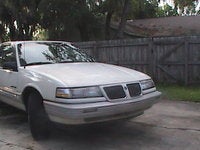2004 Grand Am Vacuum issue
Asked by Braunstreet Jul 11, 2020 at 11:31 AM about the 2004 Pontiac Grand Am SE
Question type: Maintenance & Repair
Only 10” of Vacuum. P0300 so changed plugs, wires, had cylinder 6 misfire
replaced #6 injector, replaced intake gasket. Ran worse after found bad
vacuum lines, replaced all vacuum lines. Connected gauge to accessory port
reading 10” AC made it 5” Runs very rough also slight back fire.
Thinking of where to go next
6 Answers
You have a vacuum leak somewhere! Normal vacuum is 21 inches at sea level. Do you have the 3.8L V6? If so, I'd suspect the intake manifold gaskets are leaking. Hope that helps! Jim
Braunstreet answered 4 years ago
3.4 and the upper intake gasket was replaced as well as all vacuum lines.
Get some starting fluid and spray it around the throttle body mounting gasket, lower intake manifold gaskets, and the vacuum hose connections. If the engine smooths out, you found the leak. Use short bursts of the starting fluid and stay away from the hot exhaust manifold! You might be looking at a worn timing chain or poor compression if this is a high mileage engine. A worn timing chain will cause retarded (late) valve timing the engine to run hot, and loss of power if bad enough. Run a compression test and see what you have. Around 150 PSI in each cylinder is normal. Hope that helps!
Braunstreet answered 4 years ago
Thank you I did the starting fluid and no change. It is high mileage. Checked one cylinder and was only getting about 90. I’ll check others and see. Low vacuum makes me think timing. Just odd coincident I only had cylinder 6 when I started. Looks like the rabbit hole gets deeper. Only spent 600 for it. Was thinking of a short first car for daughter. Timing belt looks like a pain. Also was thinking Of replacing lower intake gasket. Have emissions here so hard to slide by. I thought timing was by the ECM Can realigning pulleys get it by?
Think of the timing chain like the chain and sprockets on a bicycle. Same set up. This engine does use a timing chain tensioner but if the chain is worn badly the tensioner is probably at the end of its travel. Ignition timing is controlled by the PCM, valve timing is maintained by the proper positions of the crankshaft and camshaft which are in a way connected by the timing chain. Finish your compression test before going any deeper into the engine. At 90 PSI that cylinder isn't even firing. I suspect you have a couple more that will test low like that. If the timing chain is worn, simply repositioning it won't solve the problem. The slack in the chain will just allow the crankshaft and camshaft to move again as soon as the engine is started. Plus with all the trouble to get to it, you should just replace it. But I'd finish the compression test and go from there. Another thing to consider is these engines blow head gaskets. If you get a zero reading on two cylinders that are next to each other, the head gasket is blown between the two cylinders. This type of head gasket failure will not show up in the cooling system or as white billowing clouds of water condensation from the tailpipe. This is because the head gasket is not blown into the cooling system. Hope that helps! Jim
One correction, your engine doesn't have a timing chain tensioner. Just the old fashioned timing chain, and sprockets. So if you decide to replace it, replace all three parts. Jim
